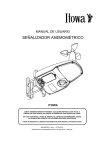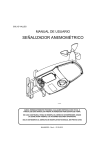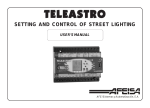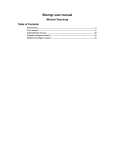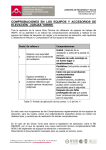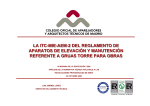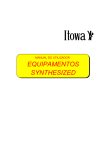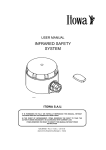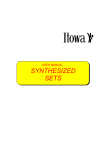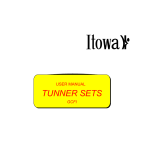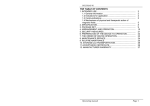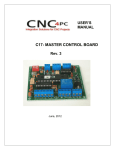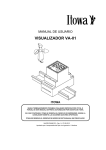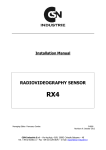Download ANEMOMETER
Transcript
USER’S MANUAL ANEMOMETER VA000906 ITOWA IT IS FORBIDDEN TO FULLY OR PARTIALLY REPRODUCE THIS MANUAL, WITHOUT THE PRIOR WRITTEN AUTHORISATION FROM ITOWA. IN THE EVENT OF INFRINGEMENT, ITOWA RESERVES THE RIGHT TO TAKE THE ACTION IT DEEMS NECESSARY, IN ACCORDANCE WITH CURRENT LAW. ITOWA RESERVES THE RIGHT TO MODIFY THIS MANUAL WITHOUT PRIOR NOTIFICATION MAANM2GB – Rev.1 – 22/06/2012 Approved by Engineering Manager: I. Martínez ANEMOMETER USER’S MANUAL 1. INTRODUCTION The Itowa’s Anemometer has been designed to fulfil the requirements of the spanish law ITC "MIEAEM-2" of the Reglamento de aparatos de elevación y manutención1, for tower cranes and other lifting aplications in construction sites. The anemometer measures the wind speed and shows two different types of alert, through visual and acoustic signals. One of them is the Warning signal, that is intermittent for more than 5 seconds and it’s activated when the wind speed surpasses the 50 Km/h (31 mph) limit but not the 70 Km/h (43,5 mph) limit, and the other is the Alarm signal, that is continuous and warns that the wind speed is faster than the 70 Km/h (43,5 mph) limit for at least 2 seconds (when it exceeds or when it decreases this limit), alerting the danger. By this way, the anemometer filters any possible false warning produced by wind gusts. It offers different solutions for installation, from the comfort of the magnetic fixation to the versatility of the quick fixing system that adapts on any vertical or horizontal surface, no matter being flat, tubular or angle. The high quality of the materials and components guarantees the highest visual and acoustic power, and a great toughness and reliability, supporting electrical shutdowns for 15 seconds. Its advanced and functional design makes possible an easy, quick and safe installation, thanks to a simple connection cover. Optionally allows: • 2 outputs per relay (Warning and Alarm). • Metallic sensor or metallic warmed sensor. • RS485 output (for connection of external devices). • Adjusting the speed triggering system (below the predetermined limits of Warning and Alarm). • 1 1 Magnetic fixation. Regulation of elevation and maintenance devices. ANEMOMETER USER’S MANUAL 2. TECHNICAL SPECIFICATIONS Sensor Horn Lights Power entry Connection Measurement system: Measure range: Resolution: Dimensions: Bitone Amber light “Warning” (triang. shape) Red light “Alarm” (round shape) Frequency: Power: 48, 115, 230 or 400 Vac (+10 / -15%) Through 2 PG9 cablegands Working temperature Protection degree: Dimensions with standard fixation: Fixation Optical 0 – 30 m/s (0-108 km/h (0 - 67 mph)) 0,06 m/s 85 x 120 x 120 mm 110 dB High luminescent diodes (100 milions of cycles) 1 Hz flashes (60/min) Amber (55 candles) Red (98 candles) 10 VA (1A fuse) Closing margin (∅ 5 ÷ 10 mm) -20 to +60 ºC (-4 to 140ºF) IP 65 306 x 226 x 170 mm Bichromium-plated steel (4 mm.plate) 3. INSTALLATION The anemometer must be placed at the top of the crane, alone, making sure that is not shielded by any part of the crane’s structure, and that is visible and accessible for an easy maintenance. The power entry connection has to be made ensuring that the anemometer will only be off when the wind free slewing manoeuvre of the crane is activated. Itowa does not claim responsability of any damage caused by a bad installation. ATTENTION!: THE SUPORT ASSEMBLY SHOULDN’T BE HIGHER THAN 15º ANGLE. ATTENTION!: THE ANEMOMETER’S FIXATION ASSEMBLY (METALLIC PARTS) MUST BE FIXED AT THE CRANE BEFORE HANGING ITS BODY (EXCEPT IN THE MAGNETIC FIXATION OPTION) 2 ANEMOMETER USER’S MANUAL 3.1. HORIZONTAL FIXATION ON A FLAT SURFACE Square section min. 30 mm VA000908 Fig. 1 : Fixation on a flat surface 3.2. HORIZONTAL FIXATION ON A TUBULAR SURFACE Round section min. 30 mm VA000910 Fig. 2 : Fixation on a tubular surface 3.3. HORIZONTAL FIXATION ON AN ANGLE Angle min. 30 mm Fig. 3. Fixation on an angle 3.4. VERTICAL FIXATION Section min. 30 mm VA000914 Fig. 4 : Vertical fixation 3 ANEMOMETER USER’S MANUAL 3.5. FIXATION PROCESS 3 2 1 Fig. 5: Fixation 1. Once the fixation group is placed at the crane (1), insert the subjection brackets of the anemometer (2) in the square holes of the fixation and anchor it with a down movement. 2. Finally, fix the anemometer with the DIN 6921 M6 screw (3). 3.6. MAGNETIC FIXATION (OPTIONAL) 5 4 2 6 3 1 Fig. 6 : Magnetic fixation 1. In the magnetic fixation, put the DIN 6921 screw (1), together with the M6 nut (3) without tighten them up, through the passing hole (6) of the metallic fixation (2). 2. Mount the metallic fixation (2) in the anemometer’s body, placing its 3 brackets inside the 3 square holes of the fixation, so the screw (1) gets placed in its final position. 3. Finally, put the other M6 DIN 6921 screw (4) and tighten up all with the M6 self-retaining nut (3). 4 ANEMOMETER USER’S MANUAL 4. All three magnets must be in contact with the crane subjection surface, that must be totally flat and with a thickness of 6-8 mm minimum. 5. For more security, after placing the anemometer at the crane, put the safety clamp (5), that NEVER must be used as the unique fixation system. 6. To take it out of the crane, you must move it from side to side holding the anemometer’s body, NEVER by the vane. CORRECT INCORRECT 3.7. ANEMOMETER’S CONFIGURATION The equipment allows different configuration types, through a minidip with 4 selectors placed within, as an auto-test function, a restart function when the Alarm signal (70 Km/h) is activated or to disable the acoustic signal in special areas as hospitals, residential zones, etc,... To access the interior of the equipment, for changing the configuration or to connect it, just take out the screws of the connection cover. Mini-dip ON 1 2 3 4 Fig. 7 : Configuration mini-dip 5 ANEMOMETER USER’S MANUAL 3.7.1. CONFIGURATION DIP1 DIP2 ON (1) Starting auto-test OFF No starting auto-test ON (1) Horn enabled OFF Horn disabled ON DIP3 OFF(1) IMPORTANT: THE Once passed the 70 Km/h limit, the ALARM signal remains activated, although the wind speed decrease to 0 Km/h (it only will get deactivated when the power is off for at least 15 seconds). The ALARM signal disappears when the wind speed is below the 70 Km/h limit. DIP4’S CONFIGURATION IT’S RESTRICTED FOR AUTHORIZED PERSONNEL ONLY. ITS RIGHT POSITION IS ON, IF THE DIP4 IS IN THE OFF POSITION THE EQUIPMENT WILL SHOW THE SENSOR ERROR MESSAGE. DIP4 ON (1) Normal function position OFF Maintenance position (1) Initial settings. 3.8. ANEMOMETER’S INTERNAL CONNECTION ON 1 2 3 4 Fuse (1A) Fig. 8: Power entry connection NOTE: Once it’s connected: 1. Tighten up the cablegand strongly against the cable for keeping it safe from liquids and dust. 2. Be sure the connection cover is closed to guarantee the total protection IP65. 6 ANEMOMETER USER’S MANUAL 4. OPERATION • AUTO-TEST When it starts, the anemometer (config. DIP1) makes an auto-test, blinking every led and acoustic signal (config. DIP2) with 2 pulses. If you have installed a Speed limit pre-selection module, see the specific section below. • ERROR SENSOR DETECTION When a failure in the sensor is produced, a broken cable is detected or there is a wrong connection (external sensor models), all the leds of the anemometer blink alternatively, not stopping until the damage is fixed. 5. OPTIONAL • MODULES o 2 Outputs per relay module (Warning & Alarm) This module (fig. 9) has 2 commuted relays (125 Vac 0,6A), potential free, that only get activated when the wind speed surpasses the WARNING and ALARM limits. The WARNING relay keeps activated continuously, while the leds blink, until the wind speed decreases under the established limit. o Speed limit pre-selection module This module (fig.9) allows you to customize the triggering limits of the different signals in high risk areas (this adjustments will always be under the WARNING and ALARM limits established by the ITC “MIE-AEM-2”, otherwise the adjustments won’t work and the equipment will return to the initial settings). If the selected configuration is different from the standard, in the auto-test function, the leds will blink 3 times instead 2. The adjustments will only be effective after restarting the equipment. 7 ANEMOMETER USER’S MANUAL DEC UNI 56 56 56 WARNING AVISO 234 234 56 234 789 01 01 789 789 01 01 789 234 ALARMA ALARM VA000919 Fig. 9 : Two outputs relay and Speed limit pre-selection module o RS485 output (peripheric devices communication) This module (fig.10) gives a RS485 output for connecting the different types of Itowa’s peripheric devices like the Events recorder or the Display device. 1 2 3 4 5 A B RS485 VA000920 Fig. 10. RS485 output module (peripheric devices) It allows too to install an external and independent sensor at a maximum 20 meters distance from the anemometer’s body (only in specific models). In these cases, you must follow the table below for connecting: (RS485 Module) CIRCUIT Ner STANDARD SENSOR WARMED SENSOR 1 White Black 2 Brown Brown 3 Green Yellow (Ground) 4 - - 5 - Blue 8 ANEMOMETER USER’S MANUAL • METALLIC SHOVELS SENSOR These shovels are made in injected aluminium alloy that gives the vane a higher toughness and makes possible, thanks to its thermal conductivity, the warmed sensor model. • WARMED SENSOR WITH METALLIC SHOVELS The warmed sensor highly improves the equipment allowing it to work on hard weather conditions with low temperature, when usually the ice, that can be formed in the sensor, blocks the vane’s rotation, disabling the equipment and consequently the security for the machine to work. This system incorporates a thermal resistor that increases progressively the temperature to the level needed for melting the frost that could have been made inside the vane. 6. RECYCLING INFORMATION FOR THE PROPER MANAGEMENT OF ELECTRIC AND ELECTRONIC DEVICES The equipment’s refuses should never be mixed with general refuses. These refuses can be delivered, without any extra cost, to the centers of refuse collection. For further information, please contact your local authorities. To recycle an electronic device separately from the general refuses avoids possible negative consequences for the environment. Furthermore, it allows a proper recycling process for all the pieces. This implies both energy and resources saving. This symbol is marked in all products. It highlights both the obligation to collaborate with the refuse collection and the warning of not using traditional containers for the elimination of the products. For further information, please contact your local authorities. 6.1. PACKAGING → The materials used for packaging are recyclable. → Please, consider the local norms with regards to the recycling of these products. 9










